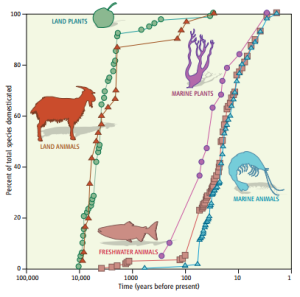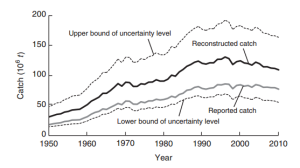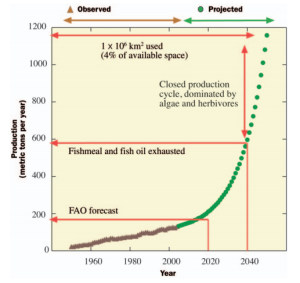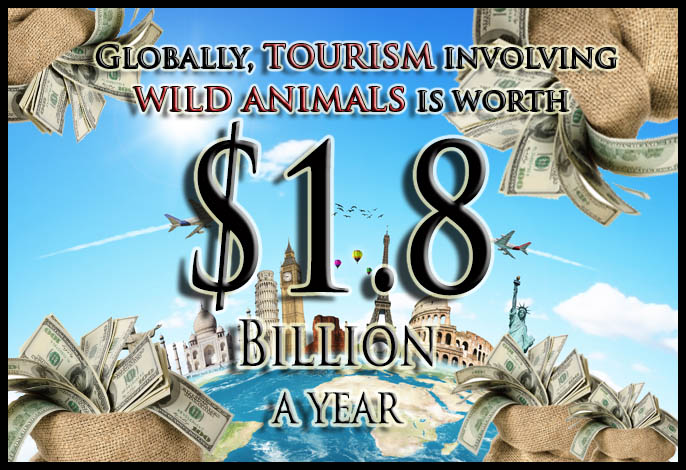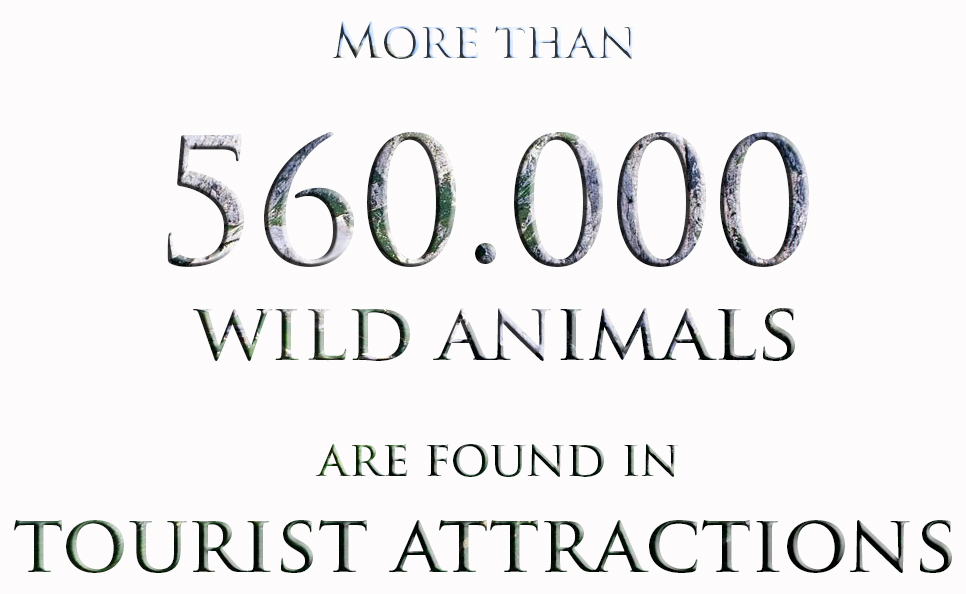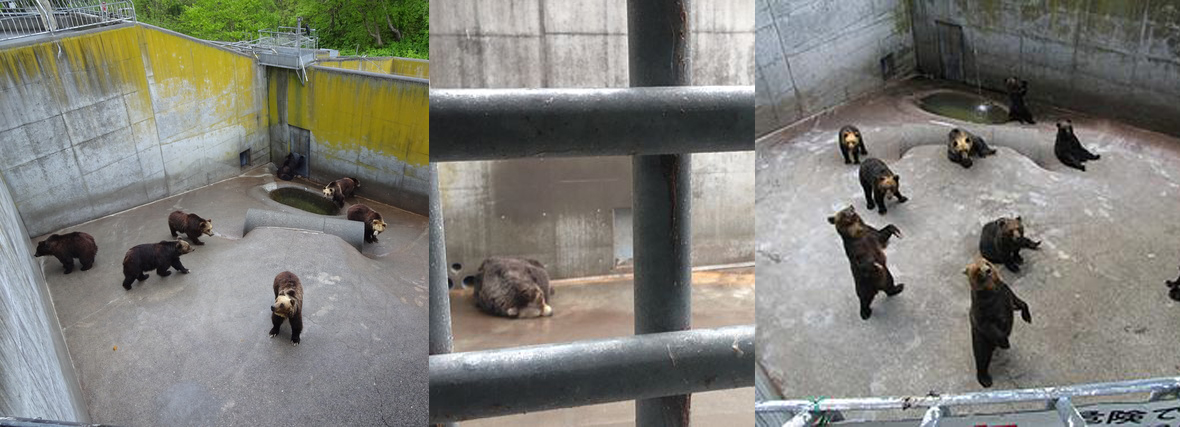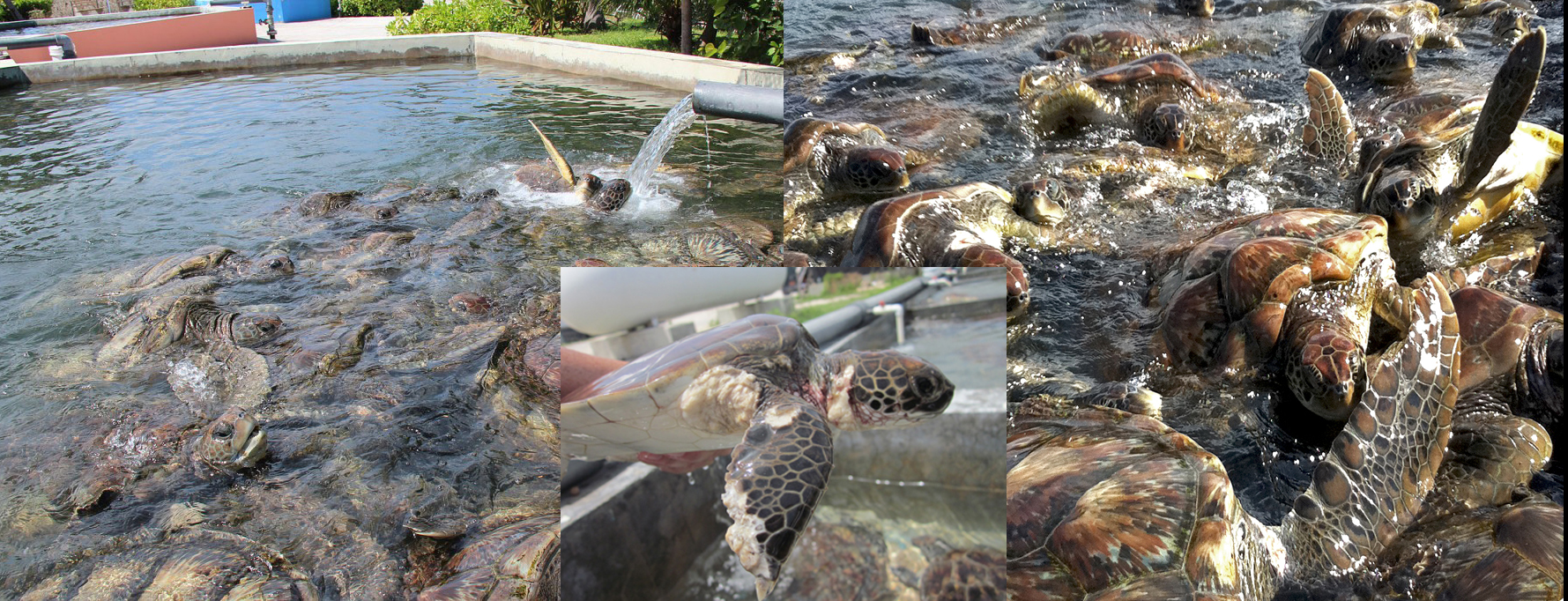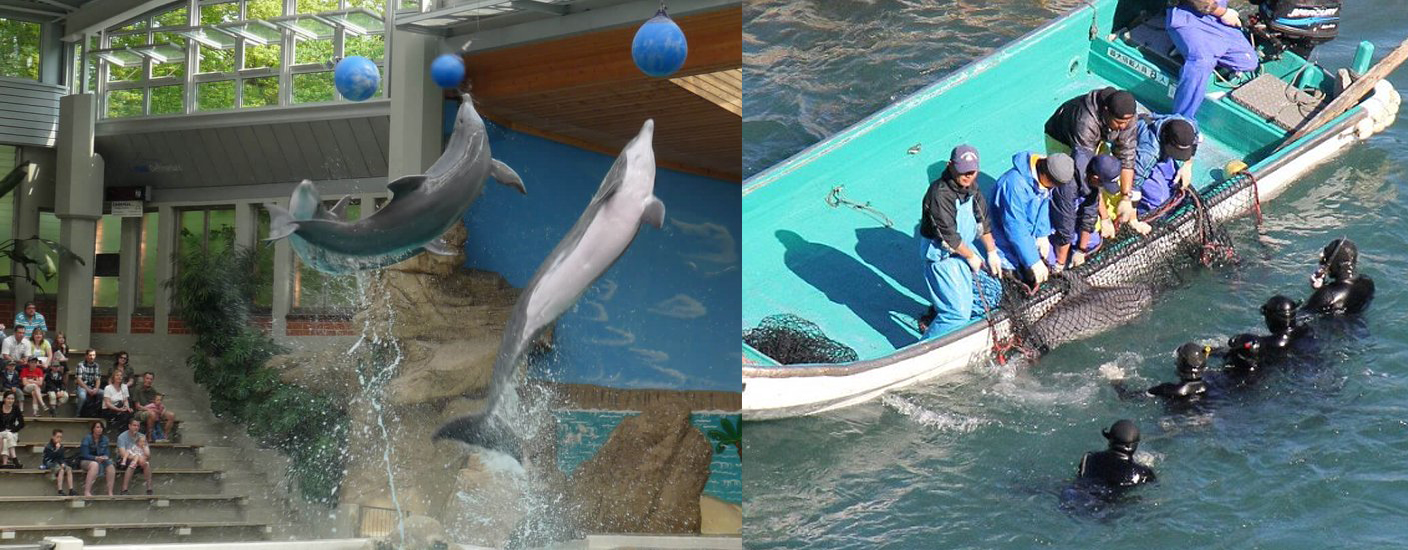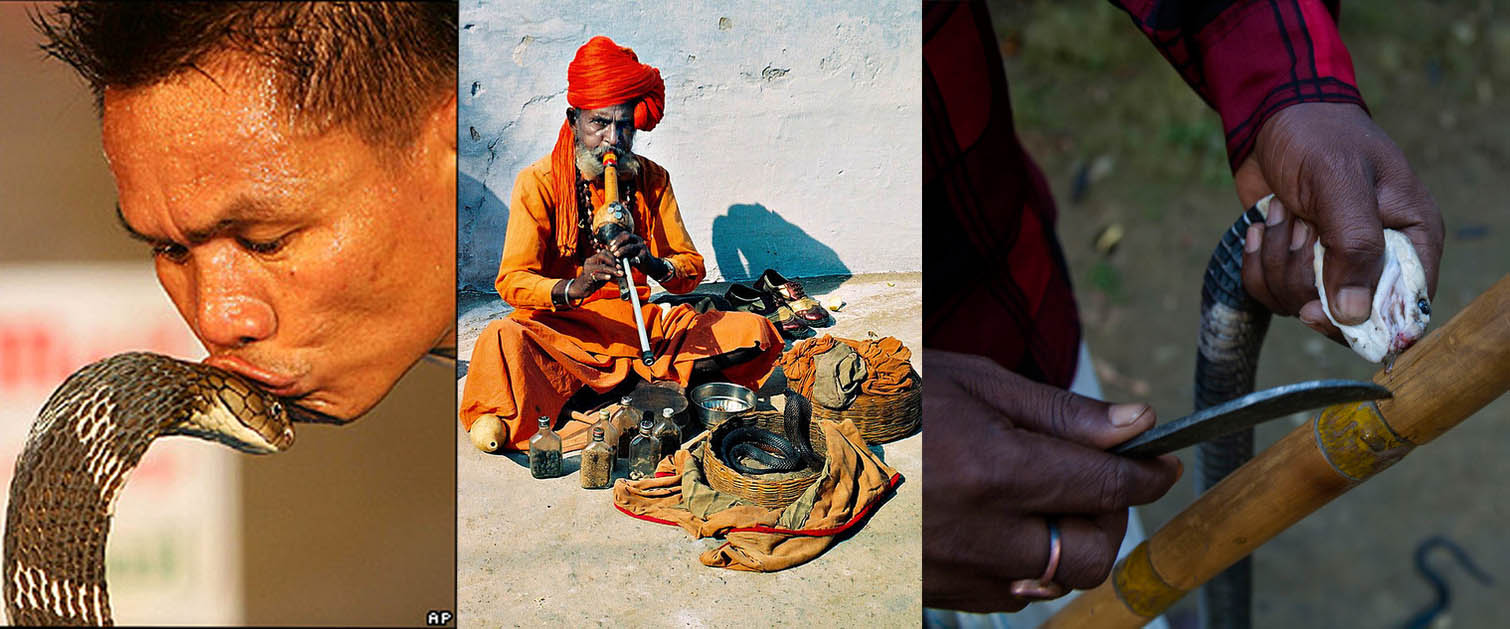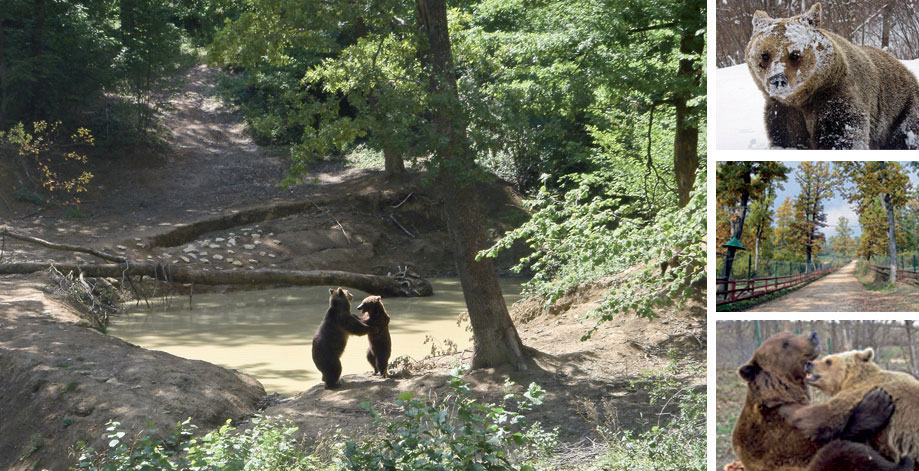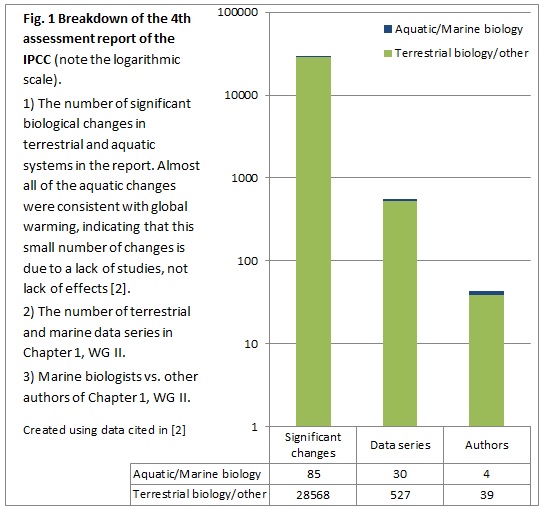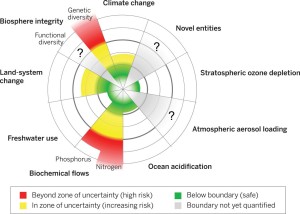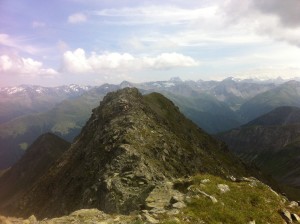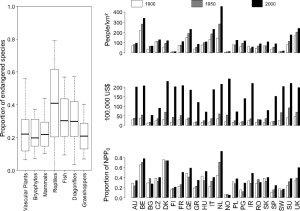Category: English
Climate change in the Himalayas
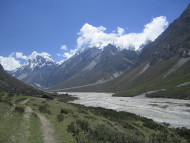
The Himalayas are the “third Pole” of the Earth, and form the largest body of ice outside the polar regions. They are the source of fresh water for a large number of rivers that flow across the Indo-Gangetic plains. The Himalayan glaciers support perennial rivers such as the Indus, Ganga and Brahmaputra, which support millions of people in South Asian countries (Pakistan, Nepal, Bhutan, India and Bangladesh). Therefore, any catastrophic change in the mountain ecosystem directly affects the lives of the people who live here, who depend directly or indirectly on the waterbodies in the mountains.
The Intergovernmental Panel on Climate Change (IPCC), claims that many Himalayan glaciers are retreating faster than in any other part of the world. However, the extent to which the Himalayan glaciers are expected to melt is uncertain.It is likely that only small glaciers will disappear in the near future, whereas large glaciers located above 5500-6000m will not disappear in this century (Vetaas 2007).
Many studies suggest that warming in the Himalayas has exceeded the global average of 0.74°C over the last 100 years (Solomon et al 2007).The rise in temperature threatens the mountain ecosystem (Shrestha et al. 1999; Nogues-Bravo et al. 2007; Colwell et al. 2008). However, mountain regions are characterized by a complex topography, which helps to provide a spatial buffer for climate change (Peterson et al. 1997). Thus, a small change in temperature does not have a huge impact on the mountain ecosystem, since a short shift uphill can be sufficient to buffer small rise in temperature(Sandel et al. 2011). Due to this topographic effect, the spatial velocity of temperature change is very high in mountain biomes of lower latitudes in comparison to plateaus at higher latitudes (Loarie et al. 2009).
The ranges of plants and animals are moving in response to recent climate change (Parmesan and Yohe 2003), and the dispersal limits of these species determines their vulnerability to local extinction (Sandel et al 2011). Species that have high dispersal capacities are less vulnerable to climate change than species with weak dispersal capacities (Loarie et al. 2009;Sandel et al. 2011).Thus, plateaus ,which are supposed to be most vulnerable to climate change tend to have species which have high dispersal capacities, whereas species which have low dispersal capacities remain in the mountains (Sandel et al. 2011).
Climate change velocity is a measure of the local rate of displacement of climatic condition over the Earth’s surface (Loarie et al 200), and is calculated by dividing the rate of climate change through time by the local rate of climate change across space (Sandel et al 2011). It has been demonstrated that the regions with the highest spatial velocity of climate change have more endemic species, and the regions with a lower spatial velocity of climate change have few endemic species(Sandel et al. 2011). Thus, mountains which have a high spatial climate velocity, support the most endemic species on earth.
The Himalayan Mountains, are likely to experience extensive changes in the environment, biodiversity, and socioeconomic conditions. Land use and land cover changes are probably the reason behind the recent changes in ecosystem functioning in the mountains (Munsi et al. 2010).The rates of loss and fragmentation in Himalayan forests pose a great threat to global biodiversity (Nautiyal and Kaechela 2007). Land use and land cover changes are the most important and easily measurable indicators of global ecological change (Lambin et al. 2001; Di Gregorio 2005). They have a direct impact on mountain biological diversity (Sala et al. 2000), which contributes to local, regional, and global climate change (Chase et al. 1999; Houghton et al. 1999). Land use and land cover change may cause land degradation by altering ecosystem services and livelihood support systems that affect the vulnerability of people (Sharma et al. 2009).
People living in the mountains are highly affected by the impact of extreme weather events. However, most of the people living in the developing world have no idea about the severe impact of long-term climate change in the mountain regions (Sharma et al. 2009). They have faced disasters all year around, including floods, increasing temperatures, storms, rainfall in the high mountains, irregular rainfall and drought. The Seti Flood in Kaski, Nepal ( in 2012) is just one example. The massive Ice-landslide on Annapurna IV (7525m.) blocked the gorge of the Seti river, and caused the devastating flood that killed 72 people and swept away various settlements (IUCN 2012).
The effects of global change in the Himalayas could ruin thousands of lives in the region, however, only few detailed studies have been carried out on observed land use and land cover change (Nautiyal and Kaechela 2007), as well as climate change (Solomon et al. 2007; Nogues-Bravo et al. 2007), and any generalizations that have been made from those could be challenging in making policies. Although the global community is currently trying to understand the effects of climate change on mountain ecosystems, a huge information gap needs to be overcome to understand Himalayan ecosystem functioning, and to maintain ecosystem resilience.
References
Chase, T.N., PielkeSr, R.A., Kittel, T.G.F., Nemani, R.R. and Running, S.W., 2000. Simulated impacts of historical land cover changes on global climate in northern winter. Climate Dynamics, 16(2-3), pp.93-105.
Colwell, R. K., Brehm, G., Cardelus, C. L., Gilman, A. C. &Longino, J. T., 2008. Global warming, elevational range shifts, and lowland biotic attrition in the wet tropics. Science, 322, 258–261.
Di Gregorio, A., 2005. Land cover classification system: classification concepts and user manual: LCCS (No. 8). Food &Agriculture Org.
Houghton, R.A., Hackler, J.L. and Lawrence, K.T., 1999. The US carbon budget: contributions from land-use change. Science, 285(5427), pp.574-578.
IUCN., 2012. The Severe Impact of Climate Change in Himalayas.http://www.iucn.org/media/media_awards/?10268
Lambin, E.F., Turner, B.L., Geist, H.J., Agbola, S.B., Angelsen, A., Bruce, J.W., Coomes, O.T., Dirzo, R., Fischer, G., Folke, C. and George, P.S., 2001. The causes of land-use and land-cover change: moving beyond the myths. Global environmental change, 11(4), pp.261-269.
Loarie, S.R., Duffy, P.B., Hamilton, H., Asner, G.P., Field, C.B. and Ackerly, D.D., 2009. The velocityofclimate change. Nature, 462(7276), pp.1052-1055.
Munsi, M., Malaviya, S., Oinam, G. and Joshi, P.K., 2010.A landscape approach for quantifying land-use and land-cover change (1976–2006) in middle Himalaya. Regional Environmental Change, 10(2), pp.145-155.
Nautiyal, S. and Kaechele, H., 2007.Conserving the Himalayan forests: approaches and implications of different conservation regimes. Biodiversity and Conservation, 16(13), pp.3737-3754.
Nogués-Bravo, D., Araújo, M.B., Errea, M.P. and Martinez-Rica, J.P., 2007.Exposure of global mountain systems to climate warming during the 21st Century. Global Environmental Change, 17(3), pp.420-428.
Vetaas, O.R., 2007. Global Change and its Effect on Glaciers and Cultural Landscape: Historical and Future Considerations. Local Effects of Global Changes in the Himalayas: Manang, Nepal. Kathmandu: Tribhuvan University (Nepal) and University of Bergen (Norway), pp.23-39.
Parmesan, C. and Yohe, G.,2003. A globally coherent fingerprint of climate change impacts across natural systems. Nature, 421, 37–42.
Sala, O.E., Chapin, F.S., Armesto, J.J., Berlow, E., Bloomfield, J., Dirzo, R., Huber-Sanwald, E., Huenneke, L.F., Jackson, R.B., Kinzig, A. and Leemans, R., 2000.Global biodiversity scenarios for the year 2100. Science, 287(5459), pp.1770-1774.
Sandel, B., Arge, L., Dalsgaard, B., Davies, R.G., Gaston, K.J., Sutherland, W.J. and Svenning, J.C., 2011. The influence of Late Quaternary climate-change velocity on species endemism. Science, 334(6056), pp.660-664.
Sharma, E., Chettri, N., Tse-ring, K., Shrestha, AB., Fang Jing., Mool, P. and Eriksson, M., 2009.Climate change impacts and vulnerability in the Eastern Himalayas. Kathmandu: ICIMOD.
Shrestha, A.B., Wake, C.P., Mayewski, P.A. and Dibb, J.E., 1999. Maximum temperature trends in the Himalaya and its vicinity: An analysis based on temperature records from Nepal for the period 1971-94. Journal of climate, 12(9), pp.2775-2786.
Solomon, S., Qin, D., Manning, M., Chen, Z., Marquis, M., Averyt, K.B., Tignor, M.M.H.L. and Miller, H.L., 2007.The physical science basis.Contribution of working group I to the fourth assessment report of the intergovernmental panel on climate change, pp.235-337.
By Prakash Bhattarai
Creating global food security – Domesticating Poseidon?
By Nickolas James Hawkes
The human population is projected to reach 9.7 billion by 2050 (UN, 2015), falling within most estimates of a global carrying capacity of 8 to 16 billion people (UNEP, 2012); however, an enormous amount of uncertainty exists in these estimates. The uncertainty stems from both natural constraints and the choices we make (Cohen, 1995). This then raises the question: How do we meet the demands of an increasing population? We can increase our food production (a technological solution, Duarte et al., 2009), lower our trophic level (change our diets, Cohen, 1995; Bonhommeau et al., 2013) and (or) ensure a more equitable distribution of resources globally (social solution, Godfray et al. 2010). Furthermore, the problem only increases in complexity when one adds the effects of climate change and resource use into the picture, as the competition for land, water and energy competes with the land available for food production (Godfray et al., 2010).
In this blog post, I wish to explore the role of the ocean in providing us food in the future, as the freshwater available for agriculture (directly and indirectly) and the consequences of increased consumption places limits on how many people agriculture can support (Duarte et al. 2009). It is interesting that our domestication of animals and plants, of landscapes and entire ecosystems (Kareiva et al., 2007) is mainly terrestrial, and that our domestication of the ocean only really “began” 100 years ago (figure 1, Duarte, Marbá and Holmer, 2007). Thus, the potential productivity of marine aquaculture – which will henceforth be defined as “mariculture” – and the smaller impact of water limitation (particularly if it is a “closed” system, see Duarte et al. 2009), provide powerful incentives.
Figure 1 (from Duarte, Marbá and Holmer, 2007). The domestication of terrestrial plants and animals began almost 10 000 years ago, whilst the domestication of marine species experienced tremendous growth in the 20th century.
You may wonder why I haven’t discussed fisheries, and the simple answer is that there is not much more “room” in expanding catches (i.e. several stocks are already overexploited, see FAO, 2014). This is reflected in the decreasing level of catches globally (figure 2, Pauly and Zeller, 2016), as well as the increase in the proportion of fisheries production used for direct human consumption (71% in the 1980s and 86% in 2012; FAO, 2014). It has also been estimated that the average recruitment capacity of global fish stocks has declined by 3% of the historical maximum per decade (Britten, Dowd & Worm, 2016). This food source, albeit “unlimited” if fished sustainably, can only support a limited amount of people, in a world of increasing people and demand. Thus a window of opportunity exists for aquaculture and mariculture to provide both food and commodities for humanity.
Figure 2 (from Pauly & Zeller, 2016). Figure showing catch per million tonnes over time with the reported catch (grey line) used in the FAO’s report (2014), and the reconstructed catch (black line). The reconstructed catch includes the reported catch plus estimates of unreported catches.
Mariculture has experienced a 10-fold increase in production in 30 years (Duarte et al., 2009), and domestication of both a wider variety of taxa and known species is occurring at rates much higher than terrestrial organisms (Duarte, Marbá and Holmer, 2007). This broader range of taxa has two important implications: One, it allows for polyculture, which can decrease the environmental impact (Neori et al. 2004), and two, it allows for a more diversified market (Duarte, Marbá and Holmer, 2007). What then are its limitations? A parallel in terrestrial agriculture, space, is likely to be one significant limitation in the future (Duarte et al., 2009). As production increases in parallel to demand, increased competition for space is an inevitable outcome. Then comes the challenge of creating closed or “integrated” food systems. This is actually a relatively simple idea, and involves using products from mariculture to feed mariculture (e.g. polyculture, Neori et al., 2004). As an example, if one was to use the maximum possible yield of fishmeal and oil to feed crab and fish mariculture (with the predicted growth rate of 7.5 % per year), production would be limited at 45 to 50 million metric tonnes per year around 2040 (figure 3, Duarte et al., 2009).
Figure 3 (from Duarte et al., 2009). Time-series showing bottlenecks and future challenges of marine food production. Observed values are depicted by brown triangles and predicted values are depicted by green circles. The predicted line is a function of 2005 levels of fish catches and harvest of macroalgal stocks, as well as mariculture’s current growth rate of 7.5% per year.
The future of mariculture certainly looks very bright, and may be the next food revolution in human history (Duarte et al., 2009). With that said, a parallel in agriculture, intensification, can bring increased risks of diseases, species introductions, loss of biodiversity and altered ecosystem services (Duarte, Marbá and Holmer, 2007; Béné et al., 2016). Thus, a sustainable model that optimises yield whilst minimising environmental impacts will be the way forward. I must also add that whilst technological solutions (e.g. polycultures and vertical farming) will aid in creating global food security, there is no single long-term solution. If productivity in food production does not “keep up” with an increasing population with increasing demands, pressure to seek short-term solutions will increase, potentially degrading the largest common of all (tragedy of the commons, Hardin, 1968). If we are to ensure sustainable and equitable food security for all, a multifaceted strategy is needed (Godfray et al., 2010).
References
- Béné, C., Arthur, R., Norbury, H., Allison, E. H., Beveridge, M., Bush, S., Campling, L., Leschen, W., Little, D., Squires, D., Thilsted, S. H., Troell, M. and Williams, M. (2016) Contribution of Fisheries and Aquaculture to Food Security and Poverty Reduction: Assessing the Current Evidence. World Development, 79, pp. 177-196.
- Bonhommeau, S., Dubroca, L., Le Pape, O., Barde, J., Kaplan, D. M., Chassot, E. and Nieblas, A. E. (2013) Eating up the world’s food web and the human trophic level. Proc Natl Acad Sci U S A, 110(51), pp. 20617-20.
- Britten, G. L., Dowd, M. and Worm, B. (2016) Changing recruitment capacity in global fish stocks. Proc Natl Acad Sci U S A, 113(1), pp. 134-9.
- Cohen, J. E. (1995) Population growth and earth’s human carrying capacity. Science, 269(5222), pp. 341-6.
- Duarte, C. M., Holmer, M., Olsen, Y., Soto, D., Marba, N., Guiu, J., Black, K. and Karakassis, I. (2009) Will the Oceans Help Feed Humanity? . BioScience, 59, pp. 967-76.
- Duarte, C. M., Marba, N. and Holmer, M. (2007) Ecology. Rapid domestication of marine species. Science, 316(5823), pp. 382-3.
- FAO (2014) The State of World Fisheries and Aquaculture 2014. in,Rome.
- Godfray, H. C., Beddington, J. R., Crute, I. R., Haddad, L., Lawrence, D., Muir, J. F., Pretty, J., Robinson, S., Thomas, S. M. and Toulmin, C. (2010) Food security: the challenge of feeding 9 billion people. Science, 327(5967), pp. 812-8.
- Hardin, G. (1968) The Tragedy of the Commons. Science, 162(3859), pp. 1243-8.
- Kareiva, P., Watts, S., McDonald, R. and Boucher, T. (2007) Domesticated nature: shaping landscapes and ecosystems for human welfare. Science, 316(5833), pp. 1866-9.
- Neori, A., Chopin, T., Troell, M., Buschmann, A. H., Kraemer, G. P., Halling, C., Shpigel, M. and Yarish, C. (2004) Integrated aquaculture: rationale, evolution and state of the art emphasizing seweed biofiltration in modern mariculture. Aquaculture, 231, pp. 361-391.
- Pauly, D. and Zeller, D. (2016) Catch reconstructions reveal that global marine fisheries catches are higher than reported and declining. Nat Commun, 7, pp. 10244.
- United Nations Department of Economic and Social Affaris / Population Division. (2015) World Population Prospects. New York: United Nations.
- United Nations Environment Programme. Global Environmental Alert Service (GEAS). (2012) One Planet, How Many People? A Review of Earth’s Carrying Capacity.
The Climate: we are changing it, and we can change it again
By Hanna Sundahl
You have probably seen by now pictures of smog engulfing major cities in China, and the pictures of burning forests in Indonesia last year. What do these have in common? They are large-scale human-induced (anthropogenic) changes. The former is attributed to the large amounts of coal produced for the Chinese energy sector (Bloomberg, 2015). The latter scenario is occurring because of a combination of predictable and unpredictable causes: large tracts of forest are burned to make way for large-scale production of e.g. oil palms (used for cooking oil, snacks, and cosmetics, among other things), but the periodic, unpredictable climate event El Niño we are experiencing right now also increases drought across the peninsula, reducing the amount of rain that otherwise extinguishes these fires (Balch, 2015).
But while this should show you at what scales we can change the planet, climate skeptics will argue that global climate change is entirely natural, not anthropogenic. Climate change does indeed occur continuously, and we can observe changes until around 400,000 years ago by looking at the gas percentages in trapped air bubbles in ice cores such as those in Antarctica (Barnola, et al., 2003). But evidence from this as well as from present-day observations like those made at the Mauna Loa volcano in Hawaii show atmospheric CO2 content and the average global temperature have been on a growing trend ever since the start of the Industrial Revolution in the 1800s, and the last decade has the been the warmest on record, see figure below (IPCC, 2014). By now, most climate scientists (97%) agree that we are seeing global warming and that this can largely be attributed to anthropogenic fossil fuel burning and land-use change (NASA, 2016). But it’s not entirely the amount of CO2 we’re releasing, but the rate that should make you turn off your TV, hop off your couch, and run over to that climate march. Digging up and burning fossils that have been sequestered over some million years disrupts the slow natural carbon cycle (IPCC, 2014). Now, considering humans have been so adept at extracting all this in such a short time, it makes sense to think that the earth is “fighting back”, trying to reach homeostasis much like a living organism.
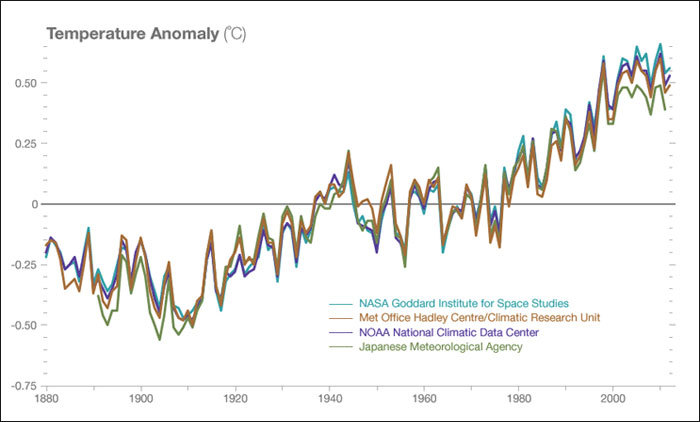
Temperature data from four international science institutions, showing an increasing trend and record warmth for the past decade. Data sources: NASA’s Goddard Institute for Space Studies, NOAA National Climatic Data Center, Met Office Hadley Centre/Climatic Research Unit and the Japanese Meteorological Agency. Image © NASA. Retrieved from: http://climate.nasa.gov/scientific-consensus/
Climate change affects us in all sorts of ways: extreme weather events increase in frequency, food security and shelter become threatened, which in turn worsens poverty and health, and destabilizes social and political infrastructures. But to fight against this, we have to be frank about what the solution is: stop using fossil fuels and start using renewable, cleaner energy. Our reluctance to switch to more renewable energy sources exists in part due to misinformation. For example, solar panel and wind turbine production are actually declining in cost, and, once installed, are essentially free, unlike plantations running on fossil fuels. Production is continuously increasing, including in Saudi Arabia and China, the latter mainly to deal with the health-damaging smog problem (Lewis, 2015). As the movie “This Changes Everything” states, perhaps the status quo Capitalism is a major source of this evil?
Al Gore sums up the motivation to fight against climate change more succinctly than I can in one blog post with his newest TED talk “The case for optimism on climate change”, which I urge you all to see → http://tinyurl.com/hpd4yxp. He lists all the challenges that I mentioned and more, but also brings to light the motivating fact that we CAN change and ARE in fact heading in the right direction to a more renewable, sustainable energy regime.
So it’s not actually the lack of investment or knowledge holding us back, though public outreach can always be improved. As cheesy as it sounds, we just need to be able to BELIEVE it is possible to slow down anthropogenic climate change.
Perhaps it’s alright for some to think we will become the next dinosaurs anyway, let’s just go about with business as usual…but, why hasten the extinction process? I don’t believe it’s a time to give up; consider instead the optimism in seeing the combined forces of people making their voices heard together with research and investment made into more sustainable solutions for the future.
References
Balch, O. (2015, November 11). Indonesia’s forest fires: everything you need to know. Retrieved from Guardian sustainable business: http://www.theguardian.com/sustainable-business/2015/nov/11/indonesia-forest-fires-explained-haze-palm-oil-timber-burning
Barnola, J. M., Raynaud, D., Lorius, C., & Barkov, N. I. (2003). Historical CO2 record from the Vostok ice core. Trends: A Compendium of Data on Global Change. Carbon Dioxide Information Analysis Center, Oak Ridge National Laboratory, U.S. Department of Energy, Oak Ridge, Tennessee, U.S.A.
Bloomberg. (2015, December 30). China to Halt New Coal Mine Approvals Amid Pollution Fight. Retrieved from Bloomberg Business: http://www.bloomberg.com/news/articles/2015-12-30/china-to-suspend-new-coal-mine-approvals-amid-pollution-fight
IPCC. (2014). Climate Change 2014: Synthesis Report. Contribution of Working Groups I, II and III to the Fifth Assessment Report of the Intergovernmental Panel on Climate Change [Core Writing Team, R.K. Pachauri and L.A. Meyer (eds.)]. Geneva: IPCC.
Lewis, A. (Director). (2015). This Changes Everything by Naomi Klein [Motion Picture].
NASA. (2016). Scientific consensus: Earth’s climate is warming. Retrieved from Global Climate Change: Vital Signs of the Planet: http://climate.nasa.gov/scientific-consensus/
Why we should care more about our coasts: coral reefs, mangroves and seagrass meadows in the tropics
By Hanna Sundahl
When you think of a tropical ocean, you probably think of pristine, turquoise waters, with colorful reefs spread below the surface teeming with fish and other stunning marine life. Indeed, this is what a healthy tropical coral reef should look like. Even though coral reefs cover less than 0.1% of the ocean surface area, they sure pack a punch in terms of biodiversity, with vertebrate species densities far greater than those found in rainforests (Kaiser, et al., 2011).

The coral reef at Heron Island, Great Barrier Reef, in all its splendor. (c) Sarah Norris, Published in Voyeur January 2014. Retrieved from: https://travel.virginaustralia.com/nz/voyeur/heavenly-heron-island
Coral reefs are a vital habitat for a number of reasons. Not only do they provide food, shelter and breeding grounds for marine life, reefs are also important for us people, since not only do they give us food (in many areas fish is the main source of protein), they also slow down wave action and serve as inexpensive coastal protection (Hoegh-Guldberg, et al., 2007). Coral reefs also have the potential to replace rainforests as the new “medicine cabinet” of nature to provide natural chemicals that can treat all sorts of human ailments (National Oceanic and Atmospheric Administration). And of course, they attract millions of tourists coming to dive and snorkel, making them a very important source of income for coastal regions (IPCC, 2014).
However, coral reefs are only part of the picture. They also have less well-known “sister ecosystems”, namely the muddy-looking mangrove forests and the seemingly simple-looking seagrass meadows. These habitats provide essential nursery spots for the juveniles of many of the fish we see while diving in coral reefs, including sweetlips, snappers, and surgeonfish (our beloved Dory) (Nagelkerken, et al., 2000). With their complex root systems keeping sediments in place, mangroves and seagrasses also help serve as coastal protection (Kaiser, et al., 2011).

Mangrove forest in Papua, Indonesia. (c) Photo credit: Ethan Daniels. Retrieved from: http://blog.nature.org/science/2013/10/11/new-science-mangrove-forests-carbon-store-map/

Seagrass meadow with predatory fish lurking above. (c) NOAA, Heather Dine. Retrieved from: http://www.amnh.org/education/resources/rfl/web/oceanguide/key.html
These three connected habitats are havens of biodiversity, sources of food and security for people, and all of them are unfortunately threatened by human coastal development. Mangroves and seagrass meadows suffer from chemical runoffs from shrimp aquaculture and farming nearby, as well as from outright mechanical destruction for land reclamation (American Museum of Natural History). Coral reefs also suffer from farmland fertilizer runoff that can cause eutrophication, leading to a habitat dominated by fast-growing algae rather than coral (Hoegh-Guldberg, et al., 2007). Careless tourists kicking and removing corals and associated living organisms, and irresponsible fishing practices like dynamite and cyanide fishing, add further pressures to these fragile ecosystems.
Considering their importance and vulnerability, protective measures need to be taken for these habitats. One such measure is to create strictly regulated Marine Protected Areas (MPAs), where limited or no human development can occur, and where visitors have to be extremely careful and considerate (National Oceanic and Atmospheric Administration). Such protected areas act as a refuge, a safe space in which biodiversity thrives, and act as a source population for re-colonization of surrounding habitat. Top priority areas are those with high endemism, where the habitat is still very intact, or that are important for feeding and breeding of long-distance migrators like manta rays or whales. The cost of maintaining MPAs is outweighed by their increased attractiveness for responsible divers and tourists in love with these healthy marine habitats.
MPAs, together with other regulations such as fishing quotas, can allow future generations to acquire the protein they need from the sea, live at the coast, and thrive on responsible tourism. Of course, there are global threats that cannot be kept out of these parks – notably ocean warming and acidification – which is why we also need to pay attention to our carbon emissions problem, the topic of my next post. But with this, I, as a diver and marine biologist, urge you to be a responsible tourist and citizen of the world and care about these fragile, yet incredibly important habitats.
References
American Museum of Natural History. (n.d.). Mangrove Threats and Solutions. Retrieved from Mangroves: the Roots of the Sea: http://www.amnh.org/explore/science-bulletins/bio/documentaries/mangroves-the-roots-of-the-sea/mangrove-threats-and-solutions
Hoegh-Guldberg, O., et al. (2007). Coral Reefs Under Rapid Climate Change and Ocean Acidification. Science, 318(1737), 1737-1742.
IPCC. (2014). Climate Change 2014: Synthesis Report. Contribution of Working Groups I, II and III to the Fifth Assessment Report of the Intergovernmental Panel on Climate Change [Core Writing Team, R.K. Pachauri and L.A. Meyer (eds.)]. Geneva: IPCC.
Kaiser, M. J., et al. (2011). Mangrove Forests and Seagrass Meadows. In Marine Ecology: processes, systems, and impacts (2nd Ed) (pp. 277-303). New York: Oxford University Press.
Kaiser, M. J., et al. (2011). Coral Reefs. In Marine Ecology: processes, systems, and impacts (2nd Ed) (pp. 305-323). New York: Oxford University Press.
Nagelkerken, I., et al. (2000). Importance of Mangroves, Seagrass Beds and the Shallow Coral Reef as a Nursery for Important Coral Reef Fishes, Using a Visual Census Technique. Estuarine, Coastal and Shelf Science, 31-44.
National Oceanic and Atmospheric Administration. Marine Protected Areas. Retrieved from http://oceanservice.noaa.gov/ecosystems/mpa/
National Oceanic and Atmospheric Administration. Medicine. Retrieved from NOAA Coral Reef Conservation Program: http://coralreef.noaa.gov/aboutcorals/values/medicine/
Treelines shift
An overview
In Alpine Mountain Environments, when we look from a distance, a kind of boundary line between trees and dwarf shrubs is visible, the fuzzy line or boundary where the trees start to disappear and shrubs and grass become dominant is what ecologists and biogeographers define as a treeline. Ecologists have defined trees as an individual plant which has a height above 2m (in the case of alpine regions) from the ground surface and treeline as the highest elevation of trees in a patch comprising at least three individuals (1). The treeline, in general, is an upper elevational limit of tree growth in mountains. These treelines are physiognomic boundaries along the elevation gradient (2) as a result of heat deficiency, i.e. these are temperature dependent (1). Elevation and latitude are the surrogate of temperature, which indirectly govern the position of treeline (figure 1). Hence, the treelines are sensitive to climate change (3). However, the extent and limit of the treeline ecotone are expected to be governed by several other confounding factors, such as the presence of herbivores, forms of treeline, land-use dynamics, geomorphology, moisture, and species interactions.
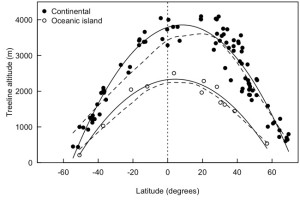
Figure 1: Treeline position around the globe by latitude for continental (filled points) and oceanic island (open points) (4).
In recent decades, there have been many studies focusing on treelines. A “treeline shift” has gained widespread attention, especially amongst vegetation ecologists, biogeographers, and environmentalists over the last few decades. The spatial and temporal span of those studies ranges from local to regional and few years to century. The majority of the small geographic studies have reported the upslope shift of treelines (5, 6); whereas some others found contrasting results (7). Researches have tried to connect the shifts with causative factors. Most of the studies found that the treeline shifts are related to landuse changes, climatic warming and moisture stress, as well as geomorphology, and species interaction.
Theoretically, a warming in climate causes the treeline to move/migrate up-slope in the case of mountains and pole-wards in latitude. This applies directly only in the absence of other interacting factor or their insignificant effect. For instance, the advance of the treeline was found to be a response to the warming in post-little ice age in the Swedish Scandes (8) and there have been several reports from various parts of the world about the treeline shift in response to the recent warming (5, 6). However, the treelines’ response to climatic warming is altered by several factors such as landuse change and disturbance in treeline ecotone.
A global meta-analysis (5) on treeline shifts found that only 52% of treelines have shifted up-slope while about 1.5% of treelines receded which shows that the trend of treeline advance is not universal. In the case of the up-slope shift, a rise in winter temperature the last century is found to be a major driver. The treeline shift is a result of the dispersal and establishment in treeline ecotone, which are highly sensitive to short extreme climatic events such as drought and extreme long clod periods. (9). Extreme events such as drought or severe frosts during growing season affect the recruitment and survival of seedlings, which ultimately affects treeline dynamics (10).
Landuse is another interacting factor that cause treeline shift. It contributes in retreat the treeline (5) or can mask or moderate the upwards shift of the treeline with climatic warming. For instance the treeline in Norway has been controlled by the presence of herbivores (11). Herbivores may consume tree seedlings or destroy them by uprooting, ultimately inhibiting the growth of treeline species in the ecotone. In such cases, once the disturbance is reduced or eliminated from the treeline ecotone, the treelines move towards its climatic limit by shifting the treeline up-slope (12).
To conclude
The response of treelines to global changes is rather complicated when both the climatic warming and landuse acts together. The climatic warming favours treelines advance up-slope while landuse causes the treelines to retreat or stabilize at the same elevation. In such cases, a balanced counteracts of the climatic warming and disturbances conceal the dynamic nature of treelines. However, land abandonment or a reduction in land use intensity may favour treeline up-slope shift. Regardless of the causes of the treeline shift, the shift is site specific and species specific. The response of treeline to climatic warming varies across the phytogeography regions (temperate to the tropical region) (7), and also depends on the form of treeline (5, 10, 13).
In the premise of continued climate change which is projected to continue throughout the 21st century, the treeline is expected to shift further upwards in the altitude and polewards in latitude. The shift may also be influenced by the landuse changes. In the mountains, the up-slope shift of treeline may increase competition and alpine species will suffer from more shade by a new shrub or forest canopy. Similarly, species which are unable to keep pace with warming will lose their suitable habitat affecting their population.
References
1. C. Körner, Alpine plant life: functional plant ecology of high mountain ecosystems. (Springer, Berlin, 2003), pp. XI, 344 s. : ill.
2. U. Schickhoff, in Mountain Ecosystems. Studies in Treeline Ecology, G. Broll, B. Keplin, Eds. (Springer Verlag, Berlin-Heidelberg-New York, 2005), pp. 275-354.
3. C. Körner, J. Paulsen, A world-wide study of high altitude treeline temperatures. J Biogeogr 31, 713-732 (2004).
4. A. Berdanier, Global treeline position. Nature education knowledge 3, 10-11 (2010).
5. M. A. Harsch, P. E. Hulme, M. S. McGlone, R. P. Duncan, Are treelines advancing? A global meta‐analysis of treeline response to climate warming. Ecology letters 12, 1040-1049 (2009).
6. A. Tiwari, Z.-X. Fan, A. S. Jump, S.-F. Li, Z.-K. Zhou, Gradual expansion of moisture sensitive Abies spectabilis forest in the Trans-Himalayan zone of central Nepal associated with climate change. Dendrochronologia, (2016).
7. E. M. Rehm, K. J. Feeley, The inability of tropical cloud forest species to invade grasslands above treeline during climate change: potential explanations and consequences. Ecography 38, 1167-1175 (2015).
8. L. Kullman, L. Öberg, Post‐Little Ice Age tree line rise and climate warming in the Swedish Scandes: a landscape ecological perspective. Journal of Ecology 97, 415-429 (2009).
9. S. T. Gray, J. L. Betancourt, S. T. Jackson, R. G. Eddy, Role of multidecadal climate variability in a range extension of pinyon pine. Ecology 87, 1124-1130 (2006).
10. F.-K. Holtmeier, G. Broll, Treeline advance–driving processes and adverse factors. Landscape Online 1, 1-33 (2007).
11. J. D. Speed, G. Austrheim, A. J. Hester, A. Mysterud, Experimental evidence for herbivore limitation of the treeline. Ecology 91, 3414-3420 (2010).
12. J. D. M. Speed, G. Austrheim, A. J. Hester, A. Mysterud, Elevational advance of alpine plant communities is buffered by herbivory. J Veg Sci 23, 617-625 (2012).
13. U. Schickhoff et al., Do Himalayan treelines respond to recent climate change? An evaluation of sensitivity indicators. Earth System Dynamics 6, 245 (2015).
Differing perceptions on conserving nature
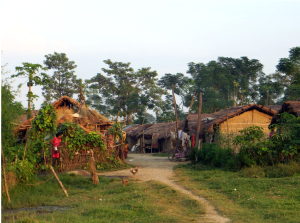
A Tharu village in the buffer zone of Chitwan National Park, Nepal. (photo: Ben Robson)
The natural world has constantly changed and developed as a result of both natural and anthropogenic influences over geological time [1], the notion of conserving and preserving landscapes for future generations is however relatively recent. In particular, a distinction exists between perceptions of how “pristine” landscapes should be conserved between the more developed “Northern” countries and the less developed nations in the “South.”
Countries in the North generally moved from a predominantly rural population to a more urbanised population during the industrial revolution, as such when national parks and conservations were established in the mid-20th century, significant populations were already settled within the new national park boundaries, thereby limiting the amount of conservation that could be carried out. National parks in Western Europe generally conform to a grade V classification according to the IUCN classification scheme (table 1), aiming to find a compromise between the needs of both mankind and nature.

75% of land within English and Welsh national parks is privately owned meaning it is seldom that pure «wilderness» is found. Activities such as farming, mineral extraction or power generation are in some cases permitted within the park, but economic activity that that could aesthetically impact the landscapes that we associate with our cultural or national identity are limited [2]. and steps are taken to preserve the building style, land-use and character of the area. For example, many would associate the Lake District National Park with William Wordsworth, traditional rustic farming, the rolling hills of England and relaxing around the lakes than they would with untouched nature. It could be argued that most British, and to an extent European national parks are therefore preserving a human-influenced landscape that we feel is in danger rather than a wilderness. Economics can be one of the biggest driving factors in establishing new parks, revenue from tourism has helped create parks in Australia, the UK and Canada during the last 20 years[2].

The Lake District, UK, has been a popular destination long before it was designated a national park in 1951. William Wordsworth famously wrote «I Wandered Lonely as a Cloud» about the area in 1802 (photo: wikipedia)
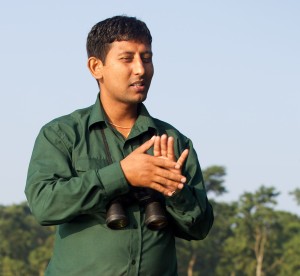
Our Tharu guide, Raju, had his father killed by a wild elephant. (Photo: Pål Ringkjøb Nielsen)
National parks in developing countries on the other hand were often established after those in industrialised nations and while a higher proportion of the population lived rurally. Some communities therefore underwent challenges to their livelihoods, or in some cases were forcibly evicted in favour of conservation [3]. Following the establishment of the Chitwan National Park in Nepal, the Tharu people faced restrictions on the amount of biomass and fruit that could be harvested, while fishing, hunting, and the amount of grazing land were also restricted [4]. Since 1964 over 22,000 Tharu have been removed from the park. Despite initial high expectations, many Tharu found the compensatory land was inadequate in terms of soil quality, resources, location and cultural value. Additionally, the re-location has affected the community social structure by mixing indigenous and hill castes [4]. The fate of the Tharu people is just one of many examples of local people being marginalised in favour of conservation, where following resettlement the population are forced to become less self-sufficient without the natural resources they previously relied upon.
It’s not just the understanding of national parks that differ between the “North” and “South” when it comes to how conservation is perceived. There is also a large distinction on how the conservation of large mammals. Despite a population of just 35 to 52 wolves, Norway kills over 25% of the population each year, and also permits the cull of bears, wolverines and even Golden eagles that have killed reindeer [5]. The wolves are exterminated based on the risk posed to farmers and their livestock. In reality however no one has been killed by a wolf in Norway since 1800 and of the 26,512 cases where farmers were richly compensated for livestock killed by wolves in 2012, only 1809 (7%) cases presented carcasses. A further 20,000 cases were rejected by the authorities [6].
That one of the world’s richest countries can kill a “critically endangered” species seems contradictory when you consider how Norway is an avid supporter of conservation in the developing world. Human-wildlife interactions are a serious problem in Nepal where 21 people were killed by wild elephants between 2008 and 2012 [7] while crops such as rice, lentils and wheat are frequently damaged by wild animals [8]. Some have argued that if less developed countries were to use similar tactics for protecting their agricultural livelihoods there would be widespread commendation [6].
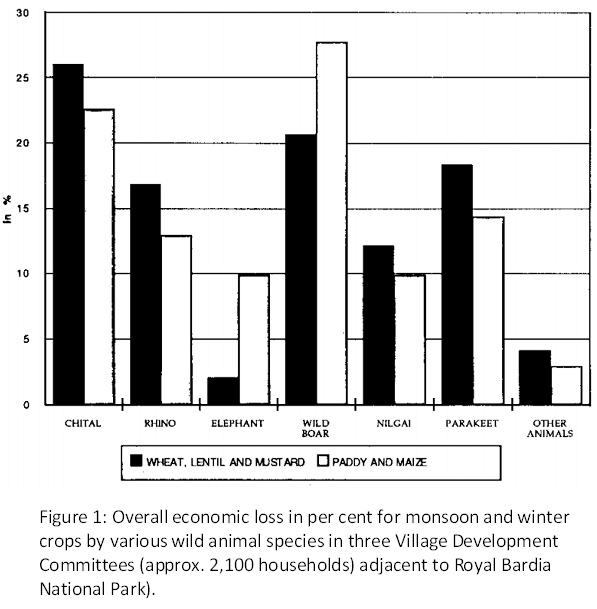
Of course, the Scandinavian countries do many great things for conservation both at home and abroad, but I think that if conservation of nature is to be addressed on a global scale then we need a global consensus of how to construe conservation. We need to decide what landscapes we are conserving and whether they should be conserved due to their importance for wildlife and nature or due to their cultural value to us and whether there should be a distinction in conservation techniques between landscapes. Similarly we cannot expect poorer nations to act on our public perception and advice concerning conserving of large mammals when we take such drastic action on curtailing animals perceived to be a threat within our own territory.
- Hannah, L., et al., Conservation of biodiversity in a changing climate. Conservation Biology, 2002. 16(1): p. 264-268.
- Woods, M., Rural geography: Processes, responses and experiences in rural restructuring. 2004: Sage.
- Brockington, D. and J. Igoe, Eviction for conservation: A global overview. Conservation and society, 2006. 4(3): p. 424.
- McLean, J. and S. Straede, Conservation, relocation, and the paradigms of park and people management – A case study of Padampur Villages and the Royal Chitwan National Park, Nepal. Society & Natural Resources, 2003. 16(6): p. 509-526.
- Monibot, G., Norway’s plan to kill wolves explodes myth of environmental virtue, in The Guardian. 2012: London.
- McPherson, B., Den norske ulveløgnen, in Aftenposten. 2013: Oslo.
- Pant, G. and M. Hockings, Understanding the Nature and Extent of Human-Elephant Conflict in Central Nepal. 2013.
- Studsrød, J.E. and P. Wegge, Park-people relationships: the case of damage caused by park animals around the Royal Bardia National Park, Nepal. Environmental conservation, 1995. 22(02): p. 133-142.
Out of sight, out of mind? Ecological change in the oceans
The oceans are greatly impacted by anthropogenic inputs, but are under-sampled. Despite indications that marine species appear to be responding as or more rapidly to global change than terrestrial species [1], only 11% of studies in the fields of ecology, conservation biology and biodiversity (1996-2004) concerned marine systems, and this is evident in large syntheses such as IPCC reports (Fig. 1; [2]). Well-known and widespread drivers of ocean change are overfishing, acidification, nutrient pollution and global warming, but there are many others [3] which receive less attention. These could lead to rapid ecosystem change, altering the provision of services we depend on such as food, water purification, or habitat for fished animals.
We understand ecological change in some marine systems fairly well. For example, kelp forests provide habitat for many seaweeds and animals, but can abruptly change into ‘barrens’ – mostly bare rock. Overfishing is an important driver – once it reaches a certain level, predators (such as cod or lobsters) become too rare and the urchin population explodes, eating all the kelp and preventing regrowth ([4]; and see this great video clip from the BBC). Coral reefs are another system where we have some understanding of large changes; once ocean acidification reaches a certain point calcification rates of corals will drop rapidly, as will coral survival at around 2 °C warming (see [3] for a summary). If this is combined with overfishing of herbivorous fish and nutrient pollution, a shift from coral to seaweed dominance is likely (e.g. in Florida [5]).
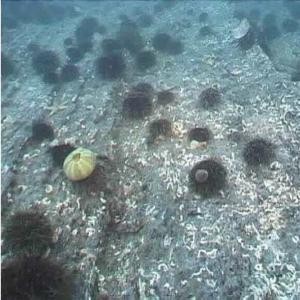
Kelp barrens dominated by urchins. Photo: NIVA (http://www.niva.no)
However, much is left to be understood even about well-known systems as we are still not sure how drivers will interact. In some cases, high pressure from one increases the impact of another, but in others, they may resist each other. For example, warming contributes to kelp forest recovery in Norway – the urchins here can only reproduce at cool temperatures, preventing warm forests from being grazed. However, in other areas, climate change negatively affects kelp forests by putting thermal stress on the kelp [6], or allowing warm-adapted urchins to expand their range [4].

Deep-sea sponges and anemones filmed from remote operated vehicles. Photos from the Centre for Geobiology, University of Bergen, Norway (http://www.uib.no/en/geobio)
We are much more in the dark about other ecosystems. The deep sea is still vastly under-sampled – we know little about what is there in the first place, let alone how it may be changing. But what we do know is that it is not the species-poor, barren landscape that it was once imagined to be. For example, there are rich faunas around hydrothermal vents which may be impacted as seabed mining becomes a reality [7,8]. Evaluation of endangered species by the IUCN also reflects lack of marine knowledge – only 9.8% of species on the red list are marine, with many species listed as ‘data deficient’ because it is difficult to get the required level of data for assessment [9]. This is a problem with terrestrial species too, but to a lesser degree than marine species – the result of this is that the extinction rate appears lower than it should be for the oceans [10], which can have effects on conservation priorities.
Some little-understood marine threats also have potentially large consequences. For example, we are aware that there is huge plastic pollution in the oceans but 99% of it is unaccounted for – we just don’t know where it is. There is a possibility that it could be accumulating biologically [11], which could have other serious knock-on effects. Chemical pollution such as PCBs can stick to plastics, thus enter the food chain more easily. PCBs themselves may be related to mass mortality events of fish or marine mammals, by increasing their susceptibility to infectious disease [12].
Conservation of the unknown
Some reasons for the lack of knowledge are practical difficulties in getting observations, poor sampling, lack of funding, and the gap between marine and terrestrial ecology [2]. These issues will have to be tackled if specific, knowledge-based conservation strategies are desired. This is possible already in some well-studied systems, where processes are sufficiently understood to allow ecosystem services-based approaches to management [e.g. 13]. For other systems, good goals could be to get knowledge to a level where we can improve the red-list for marine species, and estimate thresholds of human impacts under which ecosystems are ‘safe’. These have the advantage that they give limits and categories, which are easily communicable to policy-makers. Ways of doing this with little data may have to be developed; for example, assessing which species are threatened based on human impacts and species distribution rather than detailed, hard to get knowledge about numbers [9]. The precautionary principle can also be used – limitation of an activity because it is suspected to cause harm – but in a world where resources are limited and there is money to be made from using the environment, this can be hard to justify without enough facts.
Caroline S. Armitage
References
[1] Poloczanska ES, Brown CJ, Sydeman WJ, Kiessling W, Schoeman DS, et al. (2013) Global imprint of climate change on marine life. Nature Clim Change 3:919-925
[2] Richardson AJ, Poloczanska ES (2008) Under-Resourced, Under Threat. Science 320:1294-1295
[3] Duarte CM (2014) Global Change and the Future Ocean: A Grand Challenge for Marine Sciences. Frontiers in Marine Science 1:1-16
[4] Ling SD, Johnson CR, Frusher SD, Ridgway KR (2009) Overfishing reduces resilience of kelp beds to climate-driven catastrophic phase shift. Proceedings of the National Academy of Sciences 106:22341-22345
[5] Trivedi, B.P. (2001) Why is seaweed killing Florida’s coral reefs? National Geographic News: http://news.nationalgeographic.com/news/2001/08/0823_TVseaweed.html [Accessed 10.02.2015]
[6] Rinde E, Christie H, Fagerli CW, Bekkby T, Gundersen H, et al. (2014) The influence of physical factors on kelp and sea urchin distribution in previously and still grazed areas in the NE Atlantic. PLoS ONE 9(6) DOI: 10.1371/journal.pone.0100222
[7] Moskvitch, K. (2014) Health check for deep-sea mining. Nature 512(7513).
[8] Shukman, D. (2014) Deep sea mining licences issued. BBC News: http://www.bbc.com/news/science-environment-28442640
[9] Peters H, O’Leary BC, Hawkins JP, Roberts CM (2015) Identifying species at extinction risk using global models of anthropogenic impact. Global Change Biol 21:618-628
[10] Webb, T. and Mindel, B.L. (2014) Global patterns of extinction risk in marine and non-marine systems. Current Biology 25:1-6.
[11] Chen, A. (2014) Ninety-nine percent of the ocean’s plastic is missing. Science magazine, June 2014: http://news.sciencemag.org/environment/2014/06/ninety-nine-percent-oceans-plastic-missing [Accessed:09.02.2015]
[12] Handoh, I.C., Kawai,T. (2014) Modelling exposure of oceanic higher trophic-level consumers to polychlorinated biphenyls: Pollution ‘hotspots’ in relation to mass mortality events of marine mammals. Marine Pollution Bulletin 85(2):824-830
[13] Rogers A, Harborne AR, Brown CJ, Bozec Y-M, Castro C, et al. (2015) Anticipative management for coral reef ecosystem services in the 21st century. Global Change Biol 21:504-514
Domesticated ecosystems and their tradeoffs
Nowadays in the greater part of Europe food is something trivial, something omnipresent, something you don’t waste time to think about it’s origin. You just buy it in the supermarket and then you eat it. That’s it. Of course people are thinking and talking about food all the time, but if we are honest, it is more about, what we want to eat and what we should eat in order to maintain or gain our dream body. I can’t remember the last time, I had a conversation with a friend about how this trivial thing „food“ is produced, or even more: Which consequences could it entail to domesticate and tame not only crops and animals in order to gain food, but to domesticate whole landscapes in order to increase food production? And furthermore, what tradeoffs are we willing or not willing to accept in order to satisfy our everlasting desire for what we are used to: food at any given time and in any amount.
The fact alone that around 24% of the Earth’s terrestrial surface is occupied by cultivated systems, in order to satisfy the increasing demand for food, feed and fibre(1), makes it quite clear that the question of foodproduction is a very important one, when it comes to man-made landscape change. Therefore I decided to discuss some major points of the article „Domesticated Nature: Shaping Landscapes and Ecosystems for Human Welfare“ by Peter Kareiva et al.(2) in my blog.
In order to see the topic of domestication and land-use in general a bit more in context, I had a closer look on the planetary boundaries. In figure 1 you can see an illustration for the planetary boundaries, which are showing the risks of destabilizing the Earth system, as we know it in the Holocene, at a planetary scale. (3) As you can see Land-system change is one of the areas, that already have reached the zone of increasing risk, which means, that it has exceeded the boundary. Moreover, the area of Biochemical flows, which is by fertilization closely related to intensive cultivation of crops, is already in the high risk zone. Especially the nitrogen cycle is strongly out of balance.
Figure 1: Shows the exceeded and not exceed boundaries of the earth system. picture from: see (3) (http://www.sciencemag.org/content/347/6223/1259855.full)
Nevertheless, the reasons why humans are domesticating landscapes are easy to understand: The three main goals of domestication are increased overall productivity, promoted commerce and protection from predators and nature events, as for example storms.(2) If you only consider these three aims, then domestication is significantly enhancing the well-being of humans. But we must not forget, that there is a known price we pay for these benefits and what is perhaps even more important, that there could be so far undiscovered risks. Therefore it is most crucial to go on researching in this field, so that the tradeoffs in ecosystem services can be better understood. This is the only way I see to decide, what is a desirable management of these tradeoffs, not only for now, but also with regard to future generations.
In order to illustrate, what is meant by tradeoffs, I have chosen one example mentioned in the article for each of the three aims. The first example has the aim to maximize productivity. As mentioned before the nitrogen cycle has been strongly damaged in order to reach an increase of food production. The massive use of fertilizers in agroecosystems leads to water pollution and as a consequence to destroyed coastal zones and algal blooms (2). An example for the impacts and tradeoffs, resulting from our pursuit of promoted commerce, is the rapid spread of deseases and invasive species, indebted by the enhanced trade. (2) The third and last example is an example for the aim to avoid risks: By the removal of top carnivores, the danger for hikers, farmers and ranchers to get attacked is decreasing. But on the other hand missing predators, can lead to an enormous increase of herbivore populations, which can cause overgrazed landscapes and other damages to the ecosystem.(2) At least after these examples we can see, that the idea of tradeoffs in ecosystem services is not only crucial but also quite complex, what makes it most likely, that there are still tons of unknown consequences of domestication.
In the debate about what the best form of stewardship for the nature is, the first idea probably most people have in mind, is the conservation of wild and pristine nature.
But because of the fact, that today only 1% of the Earth’s terrestrial surface is set aside as real wilderness (4), this is quite utopian. Moreover, I think that this idea also neglects that humans will always do, what benefits them the most. Basic human needs, like food, will always be rated higher than other desirable matters.
For me that means, that we need to spend more money on research of tradeoffs and that we need to do a greater affort to understand how the ecosystems, that we are shaping, are working. This can give us better awareness of how our decisions are influecing not only the ecosystems by themselves, but also the current and prospective well-being of humankind. This personal opinion of mine fits well together with the conclusion of Kareiva et al., that an understanding of tradeoffs made in ecosystem services is important, in order to do the step away from only trying to protect nature from human influences, towards a well-conceived management of tradeoffs among ecosystem services, from which humans and nature can simultaneously thrive. (2)
By: Bianka Mertins
References:
(1) Millennium Ecosystem Assessment, Ecosystems and Human Well-Being: Current State and Trends, Chapter 26, Island Press, 2005: http://www.unep.org/maweb/documents/document.295.aspx.pdf (accessed: 16.02.2015).
(2) Kareiva, P., et al., Domesticated Nature: Shaping Landscapes and Ecosystems for Human Welfare, Science, 2007.
(3) Steffen, W.,Planetary boundaries: Guiding human development on a changing planet, Science, 2015: http://www.sciencemag.org/content/347/6223/1259855.full (accessed:16.02.2015).
(4) UCN,World Database on Protected Areas(IUCN, Washington, DC), 2007.
Extinction debt – Do current red lists highly underestimate extinction risks?
Plants growing on high mountains are often expected to be among the first losers of the global change. When a species’ habitat changes critically the species has three options: migrate, adapt or die. Parallel with the temperature increase of the last decades, we have seen plant species migrating upwards towards colder habitats. But for high-alpine species migration is not an option as they are already sitting at the last stops – on the highest peaks. However, even after decades of climate change there have been surprisingly little extinctions. Fast adaptation maybe? No, unfortunately part of these species is already using overtime. I say overtime because their extinctions are only delayed after the disturbance, in this case climate change and increased competition (1). Extinction debt is what we call the sum of all the species with delayed extinctions (1).
Scientists modelling future distributions for alpine plant species have found out that a species might remain in its old habitat even 50 years after the habitat has changed unsuitable for the species (2). This tendency towards high delay in extinctions in high-alpine regions is mainly due to longevity of these species. Even if new plant individuals are not able to survive anymore because the habitat has gone through too much change, the old individual may remain after decades. But to be able to remain in the old habitat in the long run, the species would also need to adapt to the new environment, and for alpine specialists with long life cycles this seems very unlike.
Figure 1. Left: Chummer Schwarzhorn, a mountain top in South-Eastern Swiss Alps. Right: Glacier buttercup, a typical high alpine species feared to go extinct, growing on the same mountain. Pictures by Aino Kulonen.
Mountain tops are of great interest because changes in diversity have been fast and well reported, but after all, they represent an extreme environment, covering only a small part of earth land area and small part of total biodiversity. Indeed, we should be even more scared of underestimating the extinction risk and losing essential parts of our biodiversity everywhere. Recently it has been shown how entire Europe is carrying a heavy extinction debt on its shoulders (3). And now we are not only talking about some pretty flowers whose beauty mainly mountaineers would be able to enjoy, but hundreds of species including mammals, reptiles, insects and plants.
A practical way to investigate regional extinction risk is to look at red list species. Red lists contain species that are announced to be endangered in national level. In a recent study national proportions of endangered species were compared with the pressure these countries have put on their ecosystems in years 1900, 1950 and 2000 (3). This pressure was measured as socioeconomic activity; population density, per capita GDP and intensity of land use (Fig 2). The result is alarming: for most taxonomic groups current numbers of endangered species are mirroring the pressure for ecosystem from 1900 and 1950. This means that today’s endangeredness and extinctions are results from the damage done by human already a century ago. The extinction risks we measure today are lagging 50-100 years behind human activities.
Figure 2.Left: Proportions of species facing medium-to-high extinction risks in national red lists in 22 European countries. Right: Trends in three socioeconomic indicators in Europe (human population density in people per square kilometer; per capita GDP in 100,000 International Geary–Khamis dollars; and human appropriation of net primary productivity, which is defined here as the proportion of the total net primary productivity harvested by humans to the net primary productivity of the potential vegetation (NPP0). Figure from reference 3.
The delay in extinction risk is longest for vascular plants, bryophytes, dragonflies and grasshoppers. For long living plants, long lag is not a surprise but one would think that short living insects would correspond to habitat change faster. However, simulations have shown that insect populations could show a delay of over a century even when their habitat network has been reduced close to the extinction threshold. This might be the case in Europe where agricultural landscape is a matrix of intensively used land area and near-natural habitats. Proportions of endangered fish species are the only ones that mirror best the current pressures to the ecosystem. Fish populations might indeed suffer most directly from anthropogenic actions like water pollution and management of water systems. Proportions of endangered mammals correspond well to both 1900 and 1950’s socioeconomic activity. Shorter delay is explained by their bigger habitat sizes. Fragmentation and degradation of big habitats make species meet their extinction thresholds faster than by species with small habitats.
As the pressure for ecosystems has steadily increased after 1900, we are carrying an extinction legacy that might be massive and almost impossible to measure. The study presented here is based on direct human activities, habitat fragmentation and environmental degradation like pollution (3). Novel pressures for environment like climate change, nitrogen and acidic depositions together with invasions of new species are likely to interact with direct effects and even intensify environmental degradation. With all these different direct and indirect drivers, long lag-times blur the picture and makes it harder and harder to see what is actually causing the extinction of certain species. We might easily target completely wrong drivers with our actions.
Red lists in national and global level might be way too optimistic, because they use criteria like size and recent reduction in population and range (3). Even if the current state of a species seems fine to us, the species might be doomed to extinction already decades or even a century ago. And once we notice that something’s wrong, our attempts to improve the situation might come decades too late (3).
Good news is that once we have a broader perception of the extinction debt, it will be easier to direct conservation efforts to regions and species groups with the greatest debt. As long as a species exists there is hope to save it by habitat restoration and landscape management (1). But if the driver of extinction on mountain tops really is climate change, it is harder to act directly and fast enough to save these vulnerable species. Just like shrinking glaciers, endangered mountain plants seem to work as a touchable proof of global change, but how will we save them? Are botanical gardens our only hope to save samples of these species from increasing temperatures and competition?
by Aino Kulonen
References
- Kuusisaari et al. (2009). Extinction debt: a challenge for biodiversity conservation. Trends in Ecology and Evolution 24: 10, 564-571.
- Dullinger et al. (2012). Extinction debt of high mountain plants under twenty-first-century climate change. Nature Climate Change 2, 619-622.
- Dullinger et al. (2013). Europe’s other debt crisis caused by the long legacy of future extinctions. Proceedings of the Natural Academy of Sciences 110:18, 7342-7347.
